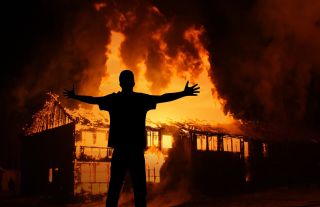Law and Crime
Is Your Next Door Neighbor a Firestarter?
Research on where different types of arsonists tend to live.
Posted July 24, 2024 Reviewed by Lybi Ma
Key points
- Arsonists may have steady jobs and no criminal record.
- Arsonists in rural areas often work in agriculture and forestry.
- There is a link between problems with alcohol and fire setting.
The Psychology of Fire Setting
We have all heard of pyromania, referring to pathological, frequent fire setting, usually for personal gratification, as opposed to other motives. As we might expect, due to the significant dangers such conduct presents to life and property, clinicians and community partners want to examine diagnostic criteria as soon as possible to consider potential treatment options and prevent disaster.
But we don’t often hear about the “fire starter next door,” as many arsonists do not light fires in their backyards—unless they have large backyards, that is. In rural areas, some of these intentionally lit fires explode into uncontained blazes that capture headlines and consume excessive amounts of land. Does that mean that rural arsonists behave differently?

Land to Burn: Rural Fire Starters
Rita Ribeiro and colleagues (2024) examined the typology of rural arsonists, seeking to characterize patterns of criminal behavior.[i] Using criminal records, they analyzed the psychological and sociodemographic characteristics, criminal behavior, and crime scene information of 450 rural arsonists. They found that 61 percent of rural arsonists had mental health issues and problems with alcohol. But compared to previous literature, most offenders were older adults, employed, and had no criminal record.
Ribeiro and colleagues classified rural arsonists into three groups:
1) Expressive – Mental Health Problems (39 percent)
2) Expressive – Alcohol Consumption (38 percent)
3) Instrumental – Socially Adjusted (23 percent).
Ribeiro and colleagues note that the primary characteristics of rural arsonists in their study revealed they were older than in most studies, with less than 20 percent at age 29 or younger, perhaps suggesting that those living in rural areas are typically older than those who live in urban areas. They also found that most were male, considering the prevalence of male offenders across all other types of crimes.
Rural Fire Setters Often Have Rural Professions
Regarding what the rural arsonists did for a living, they found that 54 percent were working, mainly in agricultural or forestry jobs as well as craft-related trades. They found that because 86 percent of the rural arsonists in their study sparked fires where they lived or worked, some of them possibly set fires on the clock. They also noted, as a practical matter, that access to the target area is easier when an offender lives or works in the vicinity, close to agricultural or forest land. Accordingly, rural arsonists who work in forestry or agriculture have a higher risk of fire setting, especially during working hours, than arsonists with other jobs.
Offenders Sparked by Expressive Motivation
Ribeiro and colleagues found that most of the arsonists in their study had an expressive motivation, especially for revenge or rage. Half did not know the owner of the property they lit on fire, and afterward, although most left the scene, they confessed when subsequently questioned. The composition of the second most populous group, expressive-alcohol consumption, appears to suggest that rural arsonists who struggle with alcohol also have an expressive motivation for fire setting.
Ribeiro and colleagues note that rural arsonists in the third group, instrumental-socially adjusted, set fires motivated by material gains or rewards. Interestingly, this group differed from the other two; they lived with their family, were employed in agriculture or forestry, and did not report alcohol abuse or mental health problems, suggesting better community assimilation. They also note that this group is the least prevalent and suggest that rural arsonists frequently have mental health or alcohol problems and are expressively motivated to set fires, rather than motivated for material gain.
Taken in context, apparently in seeking to understand arsonist behavior, motive matters, and so does geography. Thankfully, whether residing in urban or rural areas, alone or with family, help is available.
References
[i] Ribeiro, Rita, Duarte Teles, Luís Proença, Iris Almeida, and Cristina Soeiro. 2024. “A Typology of Rural Arsonists: Characterising Patterns of Criminal Behaviour.” Psychology, Crime & Law, February. doi:10.1080/1068316X.2024.2318373.


